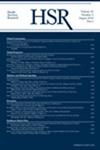Obstetric transport in rural settings: Referral and transport of pregnant patients in a state without a perinatal regionalized system of care
Abstract
Objective
To assess factors impacting obstetric transport and referral processes for pregnant patients experiencing an emergency in a rural state without a perinatal regionalized system of care.
Data Sources and Study Setting
Data is from Critical Access Hospitals (CAHs) without obstetric units and healthcare providers involved in obstetric care and transport at hospitals with varying levels of obstetric capacity in Montana.
Study Design
This mixed-methods study involved surveying CAHs without obstetric units about the hospitals' capacity for obstetric emergencies and transport policies. Survey data were collected from 32 of 34 CAHs without obstetric units (94% response rate) in the fall of 2021. Subsequent interviews were conducted in the fall and winter of 2022–2023 with 20 hospital and emergency medical services (EMS) personnel to provide further insights into the referral and transport process during obstetric emergencies.
Data Collection/Extraction Methods
Survey data were collected using REDCap; interviews were conducted via videoconference. We performed descriptive statistics and Fisher's exact tests for quantitative data. We analyzed qualitative data using a three-phase pragmatic analytic approach.
Principal Findings
The survey of CAHs found 12 of 32 facilities faced difficulties coordinating transport for pregnant patients. Qualitative data indicated this was often due to the state's decentralized transport system. Challenges identified through both quantitative and qualitative data included weather, securing a receiving facility/provider, and coordinating medical transport. Only 10 CAHs reported having written protocols for transporting pregnant patients; of those, four facilities had formal transfer agreements. Qualitative data emphasized variations in awareness and the utility of obstetric transport policies.
Conclusions
A decentralized transport system in a rural state can exacerbate existing challenges faced by providers arranging transport for pregnant patients during an obstetric emergency. State and interfacility policies could enhance the transport process for increased regionalization as well as increased support for and coordination of existing EMS.

 求助内容:
求助内容: 应助结果提醒方式:
应助结果提醒方式:


